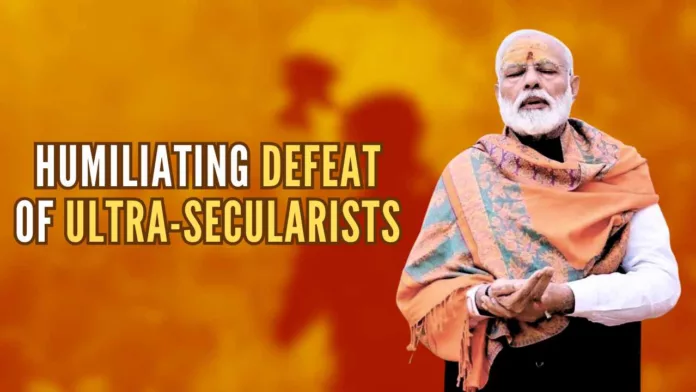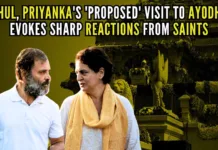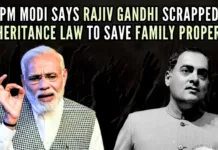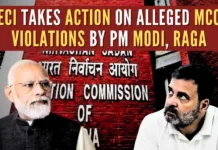
Ultra-secularists’ game plan
The ultra-secularists abused Sanatan Dharma, Hindu Gods, and Goddesses, taunted Sanatanis, and outraged their religious sensitivities through their sinister no-holds-barred campaign across the nation. They went to the extent of holding seminars and addressing press conferences to hurt Bharat, Sanatan Dharma, and Sanatanis. They even held a conference in Chennai and the theme of the conference was: Time to “Eradicate Sanatan Dharma” has come. They did everything under the Sun to further divide the Sanatanis, or further sharpen caste angularities, or pit one caste and sub-caste against another caste and sub-caste to further weaken Bharat and appease a particular section of society. They even warned their “secular” followers that their defeat would mean the conversion of India into Bharat and Bharat into Hindu Rashtra. They, in addition, left no stone unturned to create a wall of hatred between the Sanatanis and the followers of one particular religion overlooking the fact that the protagonists of the two-nation doctrine had already created out of Bharat, Pakistan, Bangladesh, and what we call Pakistan-occupied-Jammu and Kashmir. The ultra-secularists indulged in Sanatan bashing and did what they did, particularly during the past three months or so believing that such an approach would help the London-founded Congress and similar other ultra-secular outfits snatch the government in Madhya Pradesh, reestablish their anti-Sanatan rule in Rajasthan and Chhattisgarh and reduce the Sanatanis in these three very crucial states to the status of third-grade subjects. They even tried to bribe the Sanatanis in their own devious style believing that the “selfish” and “apolitical” Sanatanis would ignore the danger and threats facing Bharat and the Sanatan Dharma and come out in large numbers to vote for the ultra-secular outfits.
Political Sanatan
Did the Sanatanis walk into the trap of the ultra-secular outfits — the Congress, the Samajwadi Party (SP), the Aam Aadmi Party (AAP) and similar other outfits — in MP, Rajasthan and Chhattisgarh? No, they rejected outright and with contempt all these outfits. Impressed and influenced by the new four-caste — the poor, the youth, the women, and the kissan – doctrine, they came out in large numbers to cast their votes against all the ultra-secular outfits. The manner in which they exercised their franchise once again established that they have turned political; that they know who constitutes a live threat to Bharat, Sanatan Dharma, and Sanatanis; and that they know the path they have to charter to defeat the problems confronting the nation and their civilization, religion and culture. The manner in which the Sanatanis — cutting across caste lines — exercised their right to vote established that they have come to realize that if Bharat and they have to survive and attain a status in the comity of self-respecting nations, they have to rise above caste and other narrow considerations and vote in a fashion that controverts the baneful influence of the ultra-secularists on the nation and Sanatan Dharma.
Indeed, the crucial Assembly elections in MP, Rajasthan, and Chhattisgarh and the December 3 results proved all those wrong who had predicted the victory of the ultra-secularists in MP, Chhattisgarh, and even Rajasthan. Indeed, the December 3 results in the ultra-secularists the place they actually deserved. The point is that the Sanatanis knew the dubious game plan of the ultra-secularists and that was the reason they rejected the surreptitious means the ultra-secularists adopted and employed to further their hurt-Bharat and hurt-Sanatan Dharma agenda. And, what the Sanatanis did in these crucial states augur well for the nation and the future. There are potent and cogent reasons to believe that the April-May 2024 general elections would further reduce the strength of the ultra-secularists in the Lok Sabha, the highest law-making body and a body that discusses and decides questions of supreme importance. The belief stems from the fact that the Sanatanis have been becoming more and more political with each passing day, particularly after February 2014.
Nation’s eight immediate needs
Now that the Sanatanis have shown the way, it’s time for the Narendra Modi government, which created a history of sorts on August 5-6, 2019 by reading down the seditious Article 370, abrogating discriminatory Article 35A, freeing the enslaved Ladakh from Kashmir and conferring the status of UT on the remaining Jammu and Kashmir, to hasten the process of reforms and nation-making. The nation had hailed the Narendra Modi government for what it did on those epoch-making days, and even thereafter in Jammu and Kashmir and elsewhere, including the construction of the magnificent Ram Mandir and the effective manner in which it defended the August 2019 reform scheme in the Supreme Court of India.
The nation would further hail the Modi government if it follows below 8 points:
- Orders deportation of all illegal aliens, including Rohingyas and Bangladeshis from Bharat.
- Free Hindu temples and shrines from the official control.
- Withdraws all special scholarship schemes based on purely religious considerations.
- Implements Citizen Amendment Act (CAA) in letter and spirit.
- Orders preparation of National Register of Citizens (NRC) and National Population Register (NPR).
- Introduces Uniform Civil Code (UCC).
- Grants full state status to the discriminated against and roundly-humiliated Jammu province.
- Converts Kashmir into Chandigarh-type Union Territory so that the very vital Home, Law, Revenue, and General Administration Departments and the office of Advocate General remain under the control of the Union Home Ministry.
These are the eight immediate needs of the nation and the Modi government has the capacity and will have the mandate in May 2024 to fulfill these national requirements. Narendra Modi won 282 seats in 2014 and 303 in 2019. There are reasons to believe that he would surely win over 320 seats in May 2024. The 320+ seats would be a mandate enough to meet the nation’s seven immediate needs.
Note:
1. Text in Blue points to additional data on the topic.
2. The views expressed here are those of the author and do not necessarily represent or reflect the views of PGurus.
For all the latest updates, download PGurus App.
- ‘Kashmir My core constituency’: Revisiting July 12, 2003 to understand politics, Omar Abdullah-style - March 15, 2024
- Total deviation from traditional approach: Seven takeaways from PM Modi’s March 7 Srinagar visit - March 9, 2024
- Status of political parties: Why is further J&K reorganization imperative? - March 1, 2024










